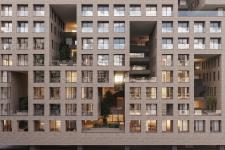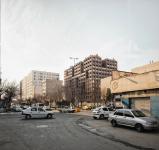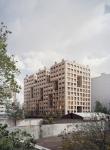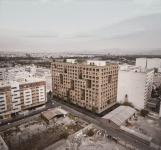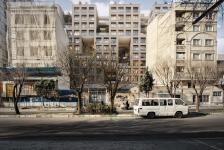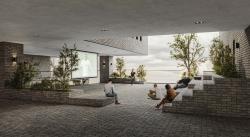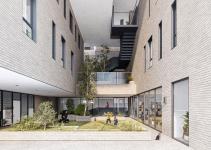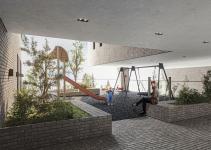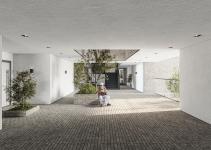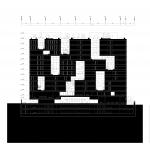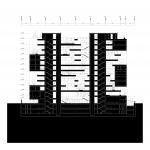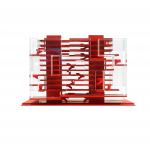Reading the geographical/historical situation in Tehran in 2022 indicates unstable conditions in various political/economic/social/cultural layers.
On the one hand, due to the failure to meet the minimum quantitative and qualitative standards and the lack of balanced development of infrastructure levels, the situation is progressing in an unfavorable and inefficient way, and on the other hand, it has become an unpredictable and uncertain situation that is on the verge of transformation. Meanwhile, due to the rapid changes in global and local paradigms, development is inevitable. A development in unstable conditions, which itself can aggravate this situation. The resulting interpretation from the formulation of these observations presents the problem in such a way that the solution is adopting a mediating attitude. A solution that criticizes any radical approach and presents itself as a contextual/critical and active position.
On the other hand, in the study of high-density housing, as a part of the subject of residence, “individuality” is proposed as an agency of the individual. In this definition, “individuality” is interpreted by examining the concept of the border as a subjective matter between the individual (private field) and social (public realm) layers.Optimizing the private residential realm and maximum adaptability to multiple situations is the study of individual residential areas. Also, paying attention to the social life in the public/semi-public areas of the concept of residence directs individuality to spatial actions in its social layer. Reclaiming everyday space and creative appropriation of space is the most important part of explaining this attitude. From this point of view, Rey (as a chosen platform for planning the construction of a residential complex) is examined with regard to the concept of development.
Historically and geographically, Rey has always been associated with the concept of development. Rey, as the southern pole of Tehran’s development in contrast to Shemiran and Tajrish (the northern pole of Tehran’s development), is considered one of the key drivers of Tehran’s urban development. The development and expansion of the middle core of Tehran (even before the time of the Tahmasabi citadel) have reached the Naseri border and Pahlavi streets considering the borders of its expansion. Today, Tehran is seeking development (due to the existence of its longitudinal limit, i.e. Shemiran and Rey) in transverse expansion. This indicates that the southern pole of Tehran’s development i.e. Rey, in contrast to its saturated northern limit i.e. Shemiran, faces a challenge to create a balance and reclaim its historical/spatial capacities, corresponding to macro-territorial and urban policies. Rey is redefining the landscape of development and trying to construct a vision of regeneration that places it in the context of development.
According to this approach, defining the problem based on reading the situation and studying the subject requires providing a solution in the direction of development. A solution that in its essence is a facilitator and catalyst of development by providing an alternative. An alternative for social housing in Rey in 2022. According to this discourse, ACCORAAC residential complex is defined in three levels: macro (residential complex), medium (public spaces) and micro (residential units). At the macro level, by studying the dominant morphology of residential complexes in the immediate context and examining the building density, ACCORAAC tries to propose an alternative, for mass loading and granularity in the spatial configuration of the context, to move forward by looking at the context.
A program with a density of 550% of the project in a land that has lost 15% of its area due to retreat creates special conditions in the clustering strategy. The use of the maximum possible occupancy level (after retreating 6 meters from the sides to provide adequate light) and the balanced and continuous organization of the empty space in the middle of the mass to achieve a unified and permeable whole, forms the overall strategy of organizing the mass and space. The project program is defined in two main parts. The residential sector includes residential units that are placed on top of each other in the form of neighborhood units in 10 residential floors and shared amenities that are located in the lower part of the project. By changing the height of the ground floor and mezzanine floor, the project offers various facilities and spatial qualities for its non-residential program. The entrance lobby, commercial spaces connected to the outside, shared work space and sports spaces are placed next to the office space and other shared facilities using higher ceilings. The project program as an independent ecosystem seeks to respond to most of the needs of its residents and users within itself.
The middle scale is the interface between the macro level and the micro level in the project. This level offers a redefinition of neighborhood units by focusing on the definition of balanced empty spaces in the project.
Allocating the empty space in the massing to the commons and the public area of the residential complex is the main part of the definition of this project because the creative appropriation and reclaiming of the space by the user will be realized in an active, diverse and multiple commons platform. The distribution of empty spaces among the mass of the project creates common open-air spaces in the resulting levels.
Spaces with diverse themes (absence of definite plan), which have organized multiple sequences with a balanced and integrated distribution on the level of each floor and the entire project. Neighborhood units that can create unpredictable opportunities for the expression of the user’s creativity as spatial actions. Possession of the common space by the immediate user of these neighborhood units, in addition to providing green and open space for the units, is a possibility to challenge the boundary of ownership and appropriation by the end user of the unit. Continuous common space that connects the entire project as a homogeneous ecosystem as a rhizomatic promenade.
ACCORAAC tries to provide a context-oriented and critical alternative to high-density housing, using the strategy of massing as a permeable integrated whole and defining continuous active common spaces, along with residential units with a high degree of flexibility, to provide desirable spatial qualities. ACCORAAC tries to facilitate and accelerate development according to the concept of individuality.
2022
Location: Iran, Tehran, ray
Total area: 26000 sqm
Lot area: 2918 sqm
Density: 502%
Number of units: 144
Unit Types: type 1: single - type 2: couple - single - type 3: couple - type 4: family
Design: Pragmatica Architectural Design Studio
Principal Architect: Mohammadreza Mohebali
Design Team: Mostafa Sadeghi - Siavash Dastgerdi
Motion Graphics: Kiana Kassaei
Exterior Visualization: Peyman Nozari – Ardalan Mashoof
Interior Visualization: Mohammad Hasan Mahdi
Client: Acco Construction Company
Strategy and Statement: Mohammad Aref Baranian
ACCORAAC: Small Home, Large Life by Mohamadreza Mohebali in Iran won the WA Award Cycle 45. Please find below the WA Award poster for this project.

Downloaded 0 times.
Favorited 3 times


